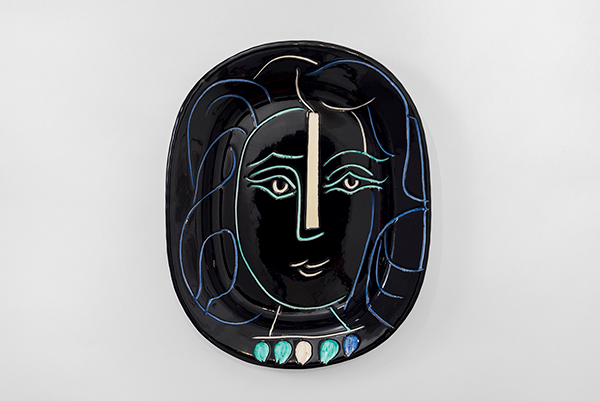Visiting the coastal town of Vallauris on France’s Côte d’Azur in the summer of 1946 for the annual pottery exhibition, Picasso was struck by the works from the local Madoura pottery. He was introduced to the pottery’s owners, Suzanne and Georges Ramié, who welcomed Picasso into their workshop, allowing him to use their tools and resources for his own experimentation with clay.
Frequently innovating with new styles and techniques throughout his career, Picasso began creating ceramic pieces with intensity. Renting a small studio close to the Madoura pottery, Picasso initially worked with simple, utilitarian objects, such as plates and bowls, later producing more complex forms, such as vases and jugs rendered with facial features or anatomical forms of figures and animals. Experimenting with a number of different methods, the most common was for him to create an original work which the ceramicists at the Madoura workshop would then replicate by hand, following the exact form and decoration of Picasso’s original. These were then produced in editions and sold directly from the Madoura pottery.
Finding working with clay less demanding than painting, Picasso devoted a significant part of his time to producing his ceramics throughout the 1950s and 1960s. Experimenting with various forms, Picasso used engraving, modelling and glazing amongst other techniques to bring the subjects of his ceramics to life. Picasso used a number of motifs in his works with clay, the iconography of bullfighting – bulls, matadors, banderilleros – which were the subject of his work in other mediums, frequently featured on his jugs, bowls and plates. Horses, fish and birds, particularly owls, also regularly featured in his ceramics.
Faces and mythological figures are other examples of Picasso’s subject matter. Reminiscent of his use of geometric, deconstructed forms in his painting, Picasso would carve and engrave faces onto plates, creating richly textured works. Woman’s Face (1953) is one of the best examples of this, using extensive glazing and subtle use of colour to create his expressive forms. One of his muses who was often the inspiration for his faces and figures was Jacqueline Roque, a ceramicist at the Madoura workshop who became Picasso’s second wife in 1961.
Above all, the artist was fascinated by the functional potential of these items. By the time that he began working with ceramics he had become one of the most celebrated and successful artists of the twentieth century, and his sculptures, paintings and drawings had a significant market. Picasso saw his editioned ceramic works as a means of democratising his artistic practice, and allowing a greater number of people to be able to afford his work. In total, he made over 600 different designs, exploring the medium until just two years before his death in 1973
(By Alexandra MacKay)
